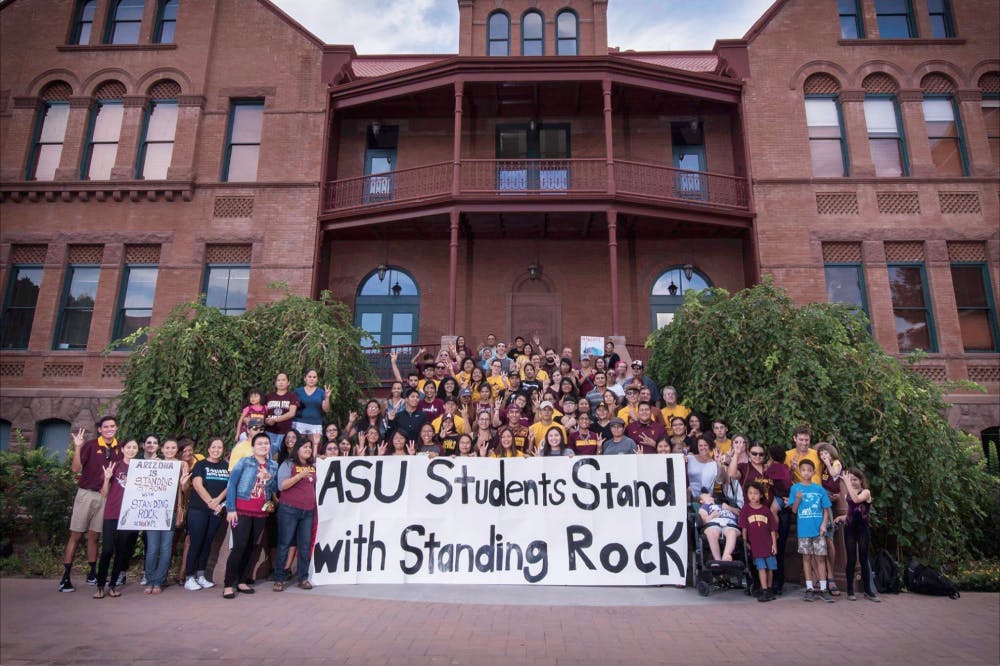Around 100 ASU students and members of the Navajo nation gathered on October 30 to stand in solidarity with the Standing Rock Sioux reservation, an area potentially impacted by the construction of the controversial Dakota Access Pipeline.
The pipeline, expected to run 1,172 miles across North Dakota to Illinois, will pass through the reservation, carrying crude oil underground to United States markets. Despite claims that the pipeline will benefit the economy, environmental activists and Native Americans say the pipeline will be damaging, contaminating the drinking water and harming sacred lands.
After recent protests in North Dakota turned violent when officers were equipped with riot gear, attack dogs and mace, students at ASU felt like they had to do something.
Cora Tso, a political science senior and member of the Navajo nation, said this realization of what was going on in Standing Rock pushed a group of Native American students to take action.
"When I saw that, it just lit a fire in my stomach and it made me sick and it made me almost cry," Tso said.
PLEASE SHARE- here in Standing Rock right now and peaceful protestors are being MACED WITH GIANT CANS #NoDAPL pic.twitter.com/nkhWyf78WJ
— Matt McGorry (@MattMcGorry) November 2, 2016
Those protests were what sparked Tso and fellow students Junior Allison and Megan Tom into action.
"That made us think, 'Hey, we should really do something as students'," Allison said.
They put together an event on Oct. 30 to take a group photo in front of Old Main showing their support for Standing Rock. Students held a sign in the picture saying, “ASU Students Stand with Standing Rock.”
Junior Allison, construction engineering junior and member of the Navajo nation, said the event was put together after witnessing how much the protests escalated.
“We thought, ‘Let’s just get a big group together, preferably students who attend ASU, and let’s take a group photo with a sign or something to show our support since we can’t physically be there',” he said.
The idea behind the event started as a way to show support for the Sioux tribe. However, the event grew to something much larger than that.
People have used the Facebook event page for the ASU picture as a way to connect with others who are going to the camp and to donate money to the cause.
“At first it started out as just getting a group together and it grew to something much more,” Allison said. “It’s actually helping with the donations and the town, and we didn’t even think of that but thankfully it happened out of that so that was just awesome.”
Allison said the event exceeded his expectations, originally thinking only 40 people would attend. Instead more than 100 people showed up.
Tso felt very strongly about the live videos she saw on Facebook on Oct. 27.
"We saw relatives and other tribal members get tased and beaten," Tso said. "We saw the dogs attack them and I think for me it was very disheartening, and I just couldn’t believe what I was seeing on the feed."
Although what she saw saddened and angered her, Tso said it was "heartwarming" to see so many non-native and non-ASU students to support them.
The NoDAPL movement has gained a huge following as the media coverage has increased and other non-natives have gotten more involved.
Celebrities like Shailene Woodley were arrested during a DAPL protest while others such as Ben Affleck and Mark Ruffalo have showed support through social media.
“I think the NoDAPL movement has made great progress in the last couple of months as more non-native people have seen that not only is this an environmental issue and a risk, but it’s a violation of human rights,” Tso said.
Americans have also been checking in to Standing Rock on Facebook under the impression doing so would prevent police from tracking protesters at the site. Allison and other students have checked in to Standing Rock even though they weren’t there.
Megan Tom, President of the American Indian Council, said she believes that it’s important for students to know what’s going on at Standing Rock because the pipeline will affect more than just the Native Americans.
“ASU students need to understand that this isn’t a Native issue, it’s a water issue,” Tom said. “This is an issue that they should be calling the federal government and also the governors in North Dakota, they should be talking to the White House and saying that this is an issue that they’re concerned about."
Reach the reporter at bmchugh4@asu.edu or follow @blakelymchugh on Twitter.
Like The State Press on Facebook and follow @statepress on Twitter.




